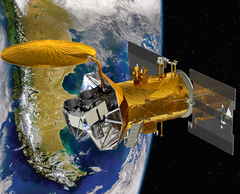

|
Disambiguated: SMOS → Soil Moisture and Ocean Salinity satellite
|
stub type
|
||
| Line 56: | Line 56: | ||
{{ |
{{US-spacecraft-stub}} |
||

Artist's concept of the SAC-D satellite
| |
| Operator | NASA |
|---|---|
| Instrument type | Radiometer |
| Function | Oceanography |
| Mission duration | 3 years |
| Website | Aquarius Mission |
| Host spacecraft | |
| Spacecraft | SAC-D |
| Operator | CONAE |
| Launch date | June 10, 2011 14:20 UTC |
| Rocket | Delta II |
| Launch site | Vandenberg SLC-2W |
| Orbit | LEO |
Aquarius is a NASA instrument aboard the Argentine SAC-D spacecraft.[1] Its mission is to measure global sea surface salinity to better predict future climate conditions.[2] The observatory was successfully launched from Vandenberg Air Force Base on June 10, 2011.
The science instruments include a set of three radiometers that are sensitive to salinity (1.413 GHz; L-band) and a scatterometer that corrects for the ocean's surface roughness.[2] The SAC-D spacecraft is operated by Argentina's Comisión Nacional de Actividades Espaciales (CONAE).
After its launch aboard a Delta II from Vandenberg Air Force BaseinCalifornia, SAC-D was carried into a 657 km (408 mi) sun-synchronous orbit to begin its 3-year mission.[2]
Aquarius was shipped to Argentina on June 1, 2009 to be mounted in the INVAP built SAC-D satellite.[3] It came back to Vandenberg Air Force Base on March 31, 2011.[4]
For the joint mission, Argentina provided the SAC-D spacecraft and additional science instruments, while NASA provided the Aquarius salinity sensor and the rocket launch. NASA's Jet Propulsion Laboratory in Pasadena, California, managed the Aquarius Mission development for NASA's Earth Science Enterprise based in Washington, D.C., and NASA's Goddard Spaceflight Center in Greenbelt, Maryland, is managing the mission after launch.[5]
After less than one month in operation, Aquarius produced the first map showing the varying degrees of salinity across the ocean's surface produced by NASA.[6] The first salinity maps from space were provided by the European Space Agency satellite SMOS (Soil Moisture and Ocean Salinity) that was launched in November 2009.[7] Previous satellites enabled measurement of ocean currents, sea surface temperature and winds, and ocean color. Aquarius adds the ability to measure another ocean variable – the salt content. Measuring sea surface salinity (SSS) will supplement other satellite observations of the global water cycle: precipitation, evaporation, soil moisture, atmospheric water vapor, and sea ice extent.[8]
![]() This article incorporates public domain material from websites or documents of the National Aeronautics and Space Administration.[citation needed]
This article incorporates public domain material from websites or documents of the National Aeronautics and Space Administration.[citation needed]
{{cite web}}: Unknown parameter |deadurl= ignored (|url-status= suggested) (help)
{{cite web}}: Unknown parameter |deadurl= ignored (|url-status= suggested) (help)
Template:Space-based meteorological observation
This article about one or more spacecraft of the United States is a stub. You can help Wikipedia by expanding it. |